Wednesday, 24 December 2008
Golden Dynasty, 14 Lisle Street, Chinatown, London WC2H 7BE
Every weekend, there is what is known as ‘The Parking Experience’ going on in most Chinatowns around the world. What is this experience, you curiously ask.
The Parking Experience
1. Arrive in Chinatown, feeling smug that you’ve arrived before noon, which is when most people arrive for dim sum lunch. Think to self, ‘There’s no way I won’t get a space now.’
2. Find out that everyone you know is having dim sum lunch that day, and that they’ve all arrived at the same time as you
3. Try to outsmart everyone else by going through ‘that little lane that no one knows about’ to get onto the main street
4. Find out that everyone else in on that little lane
5. See a spot and zoom towards it
6. Spot has a chair / cone / table in it, reserved by someone (unsure who)
7. Repeat steps 1 to 6 for another 2 hours, by which it’s time for dinner
We took the tube to Chinatown, so we didn’t have to go through The Parking Experience that day. Golden Dynasty is a restaurant recommended by a friend who’s been in London for many years, and so knows which restaurants are worth checking out in London.
There is a 30% discount promotion on dim sum here, which has been on since the first time I went there, so I would guess that it’s pretty much an on-going promotion. You basically look at the menu for what you want to order, and select that number on an order form on the table. A waiter or waitress comes by, draws around on the form (presumably highlighting what you’ve ordered), and minutes later, your table is full of plates, bowls and steamer baskets.
Prices of the dishes below are about £2.40 each, before the 30% discount
Octopus in sweet and sour type sauce (cold dish)
This is similar to a salad, in that it’s cold and comes with pickled vegetables beneath the octopus. The octopus is boiled, and then marinated in this sauce, which explains why it’s not a hot dish.
Deep fried squid rings
Up North in Manchester, there is a dim sum restaurant which does fabulous deep fried squid, but not rings. They use the tentacles of the squid, and when that is deep fried, it becomes very chewy, but also very crunchy.
Thai-style fish cakes
This was one of the best dishes that meal. The fish cakes were very juicy, and amazingly ‘springy’ (you know, like, when you chew on it, it bounces every time you chew). Fishy in taste, just enough, not too much. When you dip the fishy little cakes into the sweet and sour chilli sauce, the batter on the fishcake absorbs the flavours of the sauce, and softens just a little while making it tastier.
Century egg and pork porridge (rice congee)
I’m going to explain almost every bit of that name here.
Century egg is the name for egg which has been preserved in a mixture of clay, ash, salt, lime, and rice straw (quoted from Wikipedia) . It is also known as ‘thousand year egg’, ‘hundred year egg’, or ‘preserved egg’. When egg is preserved in this mixture, the white of the egg becomes translucent black, while the yolk just gets slightly darker in colour. Taste-wise, it’s not too dissimilar to a pickled egg, but the yolk has a more sulphuric taste to it. It’s generally eaten in thin slices, with pickled ginger to balance out the strong taste of the egg.
Porridge, when spoken in reference to Chinese cuisine, refers to rice porridge, and not to the oatmeal porridge that is eaten for breakfast. This is made by boiling rice in lots more water than usually used when cooking rice, and boiling until the rice grains break down into a starchy rice mixture. Because it doesn’t have much flavour, rice porridge is usually eaten with pickled or preserved vegetables and meat, or cooked with meat and vegetables to absorb the flavours from it.
The dish shown above is rice porridge which has been cooked with pork slices and century egg, and can also be a breakfast dish.
Har gau, or prawn dumplings
Juicy king prawns wrapped like little catterpillars in a translucent rice-based wrapper, and steamed. When you bite into it, the soft rice paper skin clings onto the prawns, like a shiny, chewy skin, and the prawns are crunchy when chewed on.
Prawn and chive dumplings
These translucent little parcels contain minced pork, chives and perhaps some fish paste because they were quite chewy and I don’t think that was from the pork alone. There is some juice from the meat and prawn mixture in the dumpling, as when you take the first bite, a little bit of juice smooshes out.
Whelk in satay sauce
Whelks are little snails, but with some differences. Otherwise, they’d be called snails in satay sauce. A whelk is a sea snail, while a snail is of the non-snorkeling variety. Apparently, in the US, whelks known by the more delicious-sounding name of ‘scungilli’.
These little pieces are chewy, and absorb the satay sauce very well. While some people don’t like chewy bits of food, I really really do like chewy food. Texture is probably more important than taste to me, usually, and in terms of texture, chewy is on the top of the list.
Deep-fried beancurd skin wrapped around prawns
Beancurd skin, when deep-fried, is crunchy and crumbly, kinda like rustly newspaper. The dip that comes with this is Lea & Perrins sauce, which is sweet and tangy so the fried parcels are nicely balanced out by the sauce.
Mini octopus in curry sauce
The taste of this dish is similar to that of the satay sauce. If they weren’t called different things, I’d guess that had the same sauce base to begin with, minus the peanut used in the satay sauce. Apparently, octopus have little teeth (as in, small teeth). Such a comforting notion when you’re chewing on it whole, wondering when it’s going to chew on you.
Cha leong (steamed rice-noodles with a fried cruller filling)
The reason this dish works is due to the contrast in textures; soft and silky from the steamed noodles, and crispy with absorbed sauce from the fried crullers. The sauce that comes drizzled on the noodle is based on soy-sauce.
Cheong fun with king prawns (steamed rice-noodle with king prawns)
This dish is like the one above, but with a different filling. Because both the prawns and the rice noodle can’t be steamed for too long, the prawn is cooked just nicely to retain the crunch and juice within the noodles.
Black bean pork ribs and chicken feet with rice, in a claypot
This was not cooked in the claypot it came in. Clues? Well, the pot was a dazzling shade of white on the inside, without any cooking stains. The dish wasn’t hot (as it should be when cooked in a claypot) when it was brought out. The third clue was the fact that the rice came out so smooth when scooped from the pot, without being even a little bit stuck to it.
The Manchester version of this comes with a dark, sweet, soy-sauce style sauce which is supposed to be drizzled over the rice. This version came without any sauce, and because of that, it was slightly lacking in taste.
All that, between the four of us cost £30.


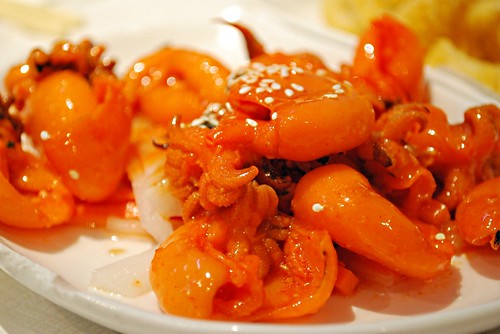
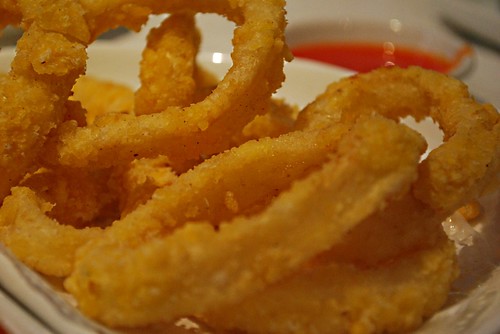
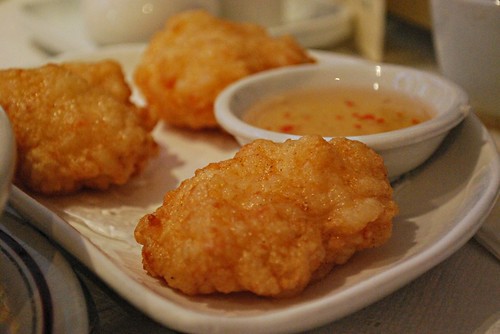
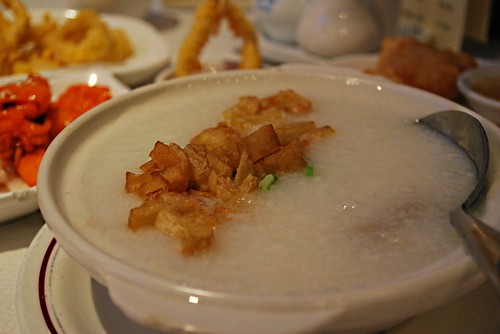
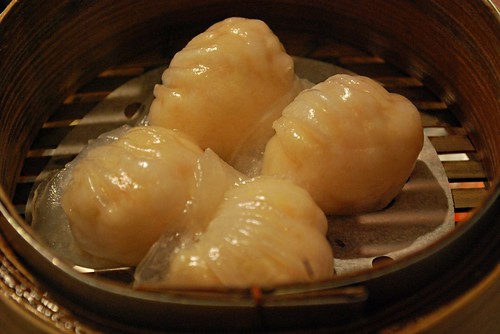
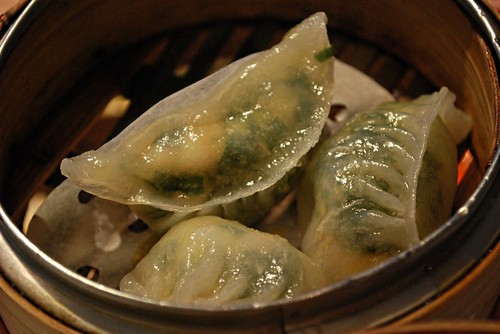
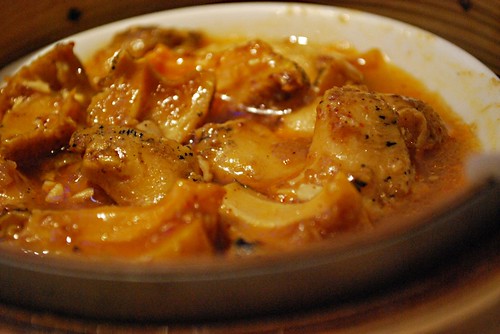
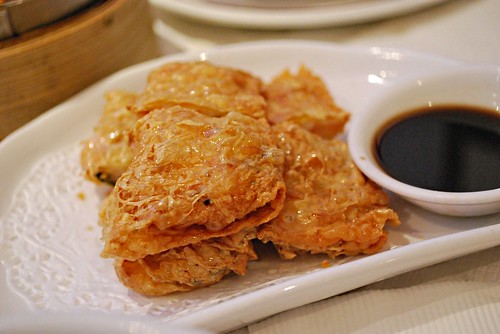
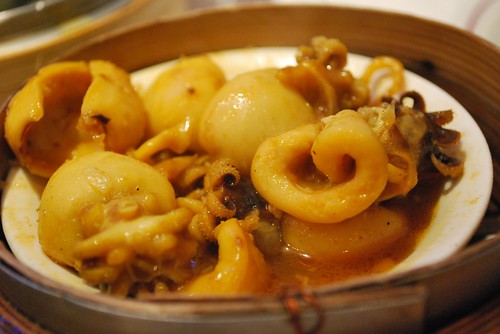
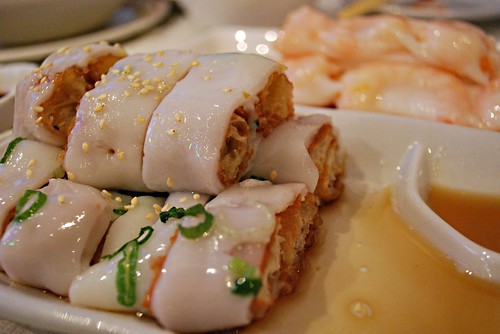
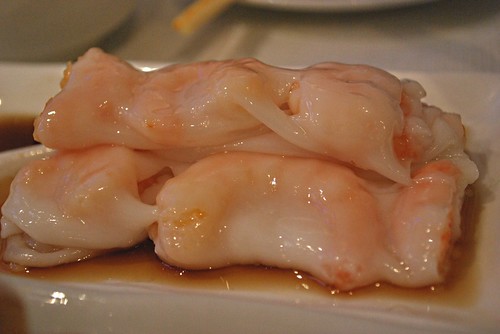
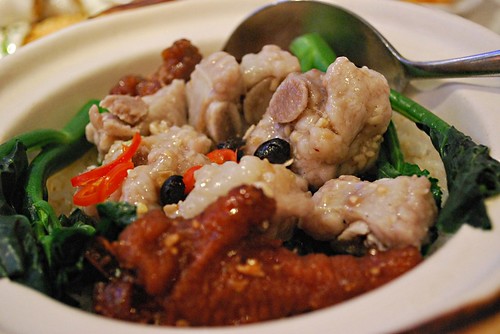
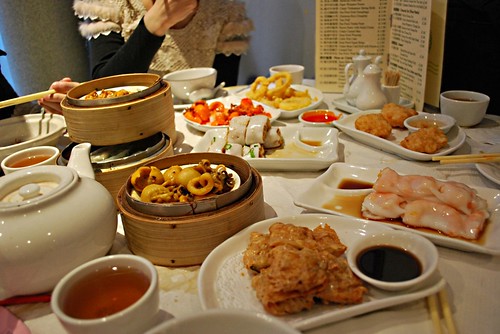


4 comments:
when i read this dimsum write up and seeing the photography, i was so excited to rush to write the comment cos iys really good!! (I also love the 2hrs looking for carpark and lunchtime becomes dinner time ha).you are so detailed and so well written, so informative and comes with really quality photography, I am again impressed!. However, if i remembered right, i did wonder that most ppl might not have too much time to read details. They might usually rely on good photography(which yours are !)to capture their taste, and maybe summary of the taste. so what i am trying to say is maybe, continue to cut down abit of details?? just my 2 cents worth. Congrats again.
Thanks for the comment! The details are there for those who wanna know more, but of course the main things are the pictures.
It seems it is the same "fight" all over, then! Here in Vancouver, depending on where you want to go for dimsum, it can be a real fight for parking spots. Fortunately, the ones I usually end up with friends are not the main ones; rather, in the suburbs and, as a result, parking is a bit "easier" to find (not by much, though).
As for price, not sure if I should be surprised or not but the cost here of a dish is not that far! (Based on 1 British Pound ~= 1.80 Canadian Dollar). Again, depending on the dimsum place, it can go from CAD $3 to CAD $6 - (1.70 GBP to 3.40 GBP); of course, the fancier, the more expensive!
Hi KimHo, like the comments, keep them coming! :)
Finding a parking space in London, especially in town, gets slightly silly sometimes because there is no congestion charge during weekends, so people take the opportunity to go to town, and since parking is mostly free on Sundays, more reason to do so!
Prices are quite steep, but after the 30% discount, it's OK, it's surprising how you get used to prices after a while!
Post a Comment